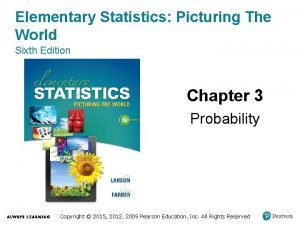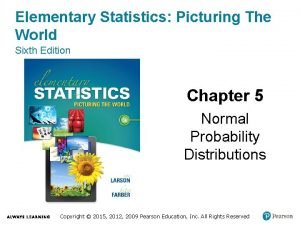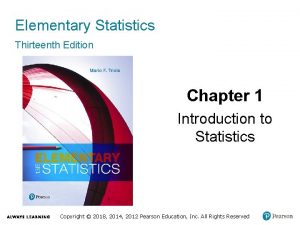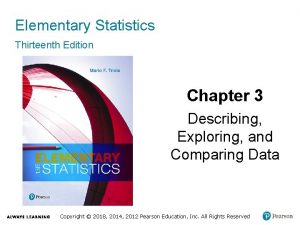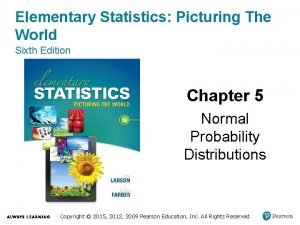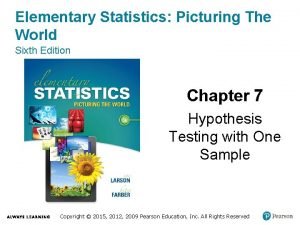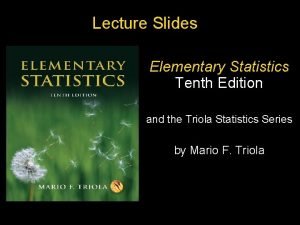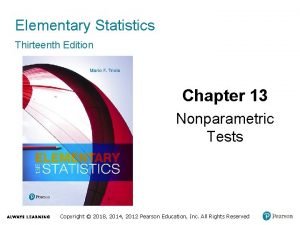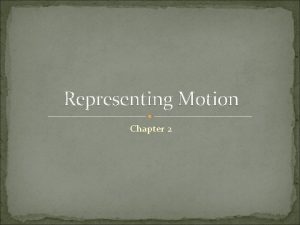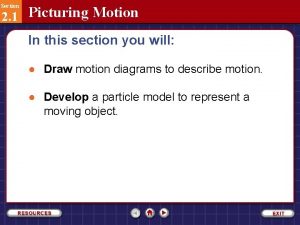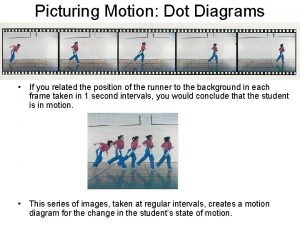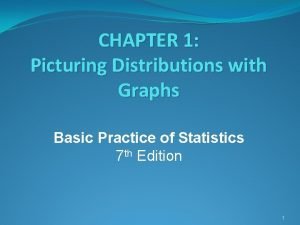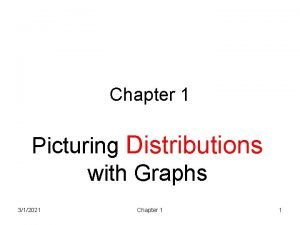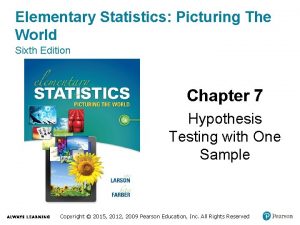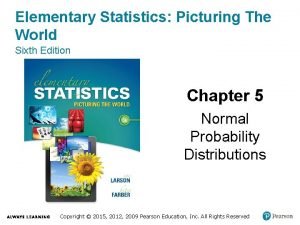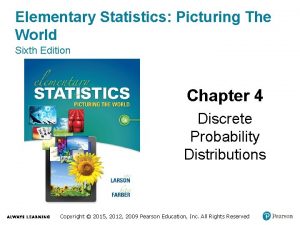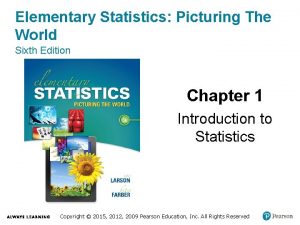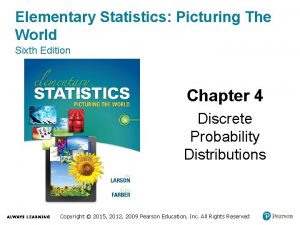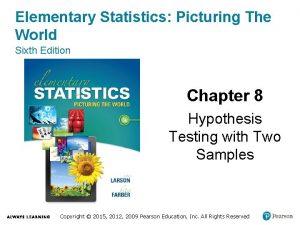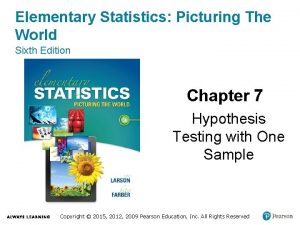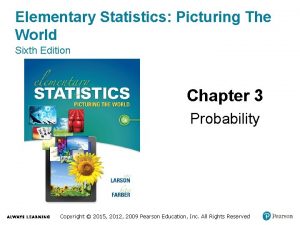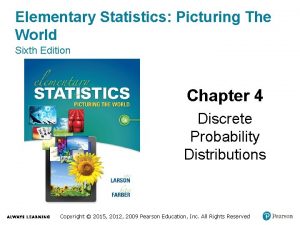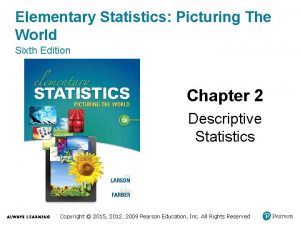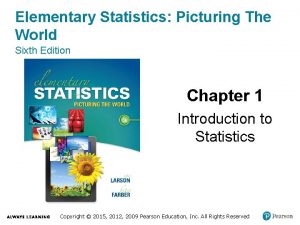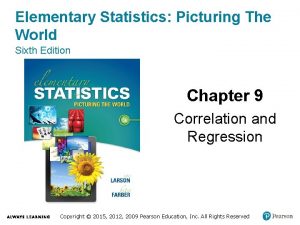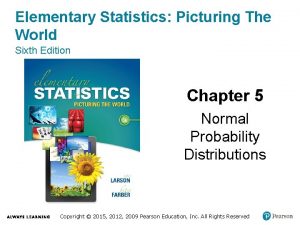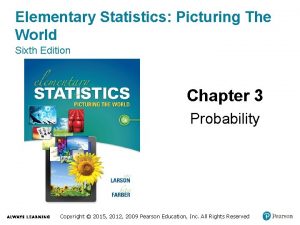Elementary Statistics Picturing The World Sixth Edition Chapter























- Slides: 23

Elementary Statistics: Picturing The World Sixth Edition Chapter 5 Normal Probability Distributions Copyright © 2015, 2012, 2009 Pearson Education, Inc. All Rights Reserved

Chapter Outline 5. 1 Introduction to Normal Distributions and the Standard Normal Distribution 5. 2 Normal Distributions: Finding Probabilities 5. 3 Normal Distributions: Finding Values 5. 4 Sampling Distributions and the Central Limit Theorem 5. 5 Normal Approximations to Binomial Distributions Copyright © 2015, 2012, 2009 Pearson Education, Inc. All Rights Reserved

Section 5. 5 Normal Approximations to Binomial Distributions Copyright © 2015, 2012, 2009 Pearson Education, Inc. All Rights Reserved

Section 5. 5 Objectives • How to determine when the normal distribution can approximate the binomial distribution • How to find the correction for continuity • How to use the normal distribution to approximate binomial probabilities Copyright © 2015, 2012, 2009 Pearson Education, Inc. All Rights Reserved

Normal Approximation to a Binomial (1 of 3) • The normal distribution is used to approximate the binomial distribution when it would be impractical to use the binomial distribution to find a probability. • Let n represent the number of independent trials, p is the probability of success in a single trial, and q is the probability of failure in a single trial. Copyright © 2015, 2012, 2009 Pearson Education, Inc. All Rights Reserved

Normal Approximation to a Binomial (2 of 3) Normal Approximation to a Binomial Distribution • If np 5 and nq 5, then the binomial random variable x is approximately normally distributed with Copyright © 2015, 2012, 2009 Pearson Education, Inc. All Rights Reserved

Normal Approximation to a Binomial (3 of 3) • Binomial distribution: p = 0. 25 • As n increases the histogram approaches a normal curve. Copyright © 2015, 2012, 2009 Pearson Education, Inc. All Rights Reserved

Example 1: Approximating the Binomial (1 of 2) Decide whether you can use the normal distribution to approximate x, the number of people who reply yes. If you can, find the mean and standard deviation. 1. Sixty-two percent of adults in the U. S. have an HDTV in their homes. You randomly select 45 adults in the U. S. and ask them if they have an HDTV in their homes. Copyright © 2015, 2012, 2009 Pearson Education, Inc. All Rights Reserved

Example 1: Approximating the Binomial (2 of 2) Solution • You can use the normal approximation n = 45, p = 0. 62, q = 0. 38 np = (45)(0. 62) = 27. 9 nq = (45)(0. 38) = 17. 1 Copyright © 2015, 2012, 2009 Pearson Education, Inc. All Rights Reserved

Example 2: Approximating the Binomial (1 of 2) Decide whether you can use the normal distribution to approximate x, the number of people who reply yes. If you can find, find the mean and standard deviation. 2. Twelve percent of adults in the U. S. who do not have an HDTV in their home are planning to purchase one in the next two years. You randomly select 30 adults in the U. S. who do not have an HDTV and ask them if they are planning to purchase one in the next two years. Copyright © 2015, 2012, 2009 Pearson Education, Inc. All Rights Reserved

Example 2: Approximating the Binomial (2 of 2) Solution • You cannot use the normal approximation n = 30, p = 0. 12, q = 0. 88 np = (30)(0. 12) = 3. 6 nq = (30)(0. 88) = 26. 4 • Because np < 5, you cannot use the normal distribution to approximate the distribution of x. Copyright © 2015, 2012, 2009 Pearson Education, Inc. All Rights Reserved

Correction for Continuity (1 of 2) • The binomial distribution is discrete and can be represented by a probability histogram. • To calculate exact binomial probabilities, the binomial formula is used for each value of x and the results are added. • Geometrically this corresponds to adding the areas of bars in the probability histogram. Copyright © 2015, 2012, 2009 Pearson Education, Inc. All Rights Reserved

Correction for Continuity (2 of 2) • When you use a continuous normal distribution to approximate a binomial probability, you need to move 0. 5 unit to the left and right of the midpoint to include all possible x-values in the interval (correction for continuity). Copyright © 2015, 2012, 2009 Pearson Education, Inc. All Rights Reserved

Example 1: Using a Correction for Continuity Use a correction for continuity to convert the binomial intervals to a normal distribution interval. 1. The probability of getting between 270 and 310 successes, inclusive. Solution • The discrete midpoint values are 270, 271, …, 310. • The corresponding interval for the continuous normal distribution is 269. 5 < x < 310. 5. The normal distribution probability is P(269. 5 < x < 310. 5). Copyright © 2015, 2012, 2009 Pearson Education, Inc. All Rights Reserved

Example 2: Using a Correction for Continuity Use a correction for continuity to convert the binomial intervals to a normal distribution interval. 2. The probability of getting at least 158 successes. Solution • The discrete midpoint values are 158, 159, 160, …. • The corresponding interval for the continuous normal distribution is x > 157. 5. The normal distribution probability is P(x > 157. 5). Copyright © 2015, 2012, 2009 Pearson Education, Inc. All Rights Reserved

Example 3: Using a Correction for Continuity Use a correction for continuity to convert the binomial intervals to a normal distribution interval. 3. The probability of getting less than 63 successes. Solution • The discrete midpoint values are …, 60, 61, 62. • The corresponding interval for the continuous normal distribution is x < 62. 5. The normal distribution probability is P(x < 62. 5). Copyright © 2015, 2012, 2009 Pearson Education, Inc. All Rights Reserved

Using the Normal Distribution to Approximate Binomial Probabilities (1 of 2) Copyright © 2015, 2012, 2009 Pearson Education, Inc. All Rights Reserved

Using the Normal Distribution to Approximate Binomial Probabilities (2 of 2) Copyright © 2015, 2012, 2009 Pearson Education, Inc. All Rights Reserved

Example 1: Approximating a Binomial Probability (1 of 2) Sixty-two percent of adults in the U. S. have an HDTV in their home. You randomly select 45 adults in the U. S. and ask them if they have an HDTV in their home. What is the probability that fewer than 20 of them respond yes? (Source: Opinion Research Corporation) Solution • Can use the normal approximation Copyright © 2015, 2012, 2009 Pearson Education, Inc. All Rights Reserved

Example 1: Approximating a Binomial Probability (2 of 2) • Apply the continuity correction: Fewer than 20 (… 17, 18, 19) corresponds to the continuous normal distribution interval x = 19. 5 Copyright © 2015, 2012, 2009 Pearson Education, Inc. All Rights Reserved

Example 2: Approximating a Binomial Probability (1 of 2) A survey reports that 62% of Internet users use Windows® Internet Explorer ® as their browser. You randomly select 150 Internet users and ask each whether they use Internet Explorer as their browser. What is the probability that exactly 96 will say yes? (Source: Net Applications) Copyright © 2015, 2012, 2009 Pearson Education, Inc. All Rights Reserved

Example 2: Approximating a Binomial Probability (2 of 2) • Apply the continuity correction: Exactly 96 corresponds to the continuous normal distribution interval 95. 5 < x < 96. 5 Copyright © 2015, 2012, 2009 Pearson Education, Inc. All Rights Reserved

Section 5. 5 Summary • Determined when the normal distribution can approximate the binomial distribution • Found the correction for continuity • Used the normal distribution to approximate binomial probabilities Copyright © 2015, 2012, 2009 Pearson Education, Inc. All Rights Reserved
 Elementary statistics picturing the world 6th edition
Elementary statistics picturing the world 6th edition Elementary statistics picturing the world 6th edition
Elementary statistics picturing the world 6th edition Elementary statistics 13th edition chapter 1
Elementary statistics 13th edition chapter 1 Inicum
Inicum The sixth sick sheik's sixth sheep's sick lyrics
The sixth sick sheik's sixth sheep's sick lyrics Elementary statistics 13th edition answers
Elementary statistics 13th edition answers Elementary statistics 6th edition
Elementary statistics 6th edition P value
P value Elementary statistics tenth edition
Elementary statistics tenth edition Elementary statistics 13th edition
Elementary statistics 13th edition Biochemistry sixth edition
Biochemistry sixth edition Computer architecture a quantitative approach sixth edition
Computer architecture a quantitative approach sixth edition Automotive technology sixth edition
Automotive technology sixth edition Automotive technology sixth edition
Automotive technology sixth edition Apa sixth edition
Apa sixth edition Computer architecture a quantitative approach sixth edition
Computer architecture a quantitative approach sixth edition Precalculus sixth edition
Precalculus sixth edition Principles of economics sixth edition
Principles of economics sixth edition Computer architecture a quantitative approach sixth edition
Computer architecture a quantitative approach sixth edition Chapter 2 representing motion
Chapter 2 representing motion Picturing motion
Picturing motion Dot diagram motion
Dot diagram motion Picturing distributions with graphs
Picturing distributions with graphs Picturing distributions with graphs
Picturing distributions with graphs
